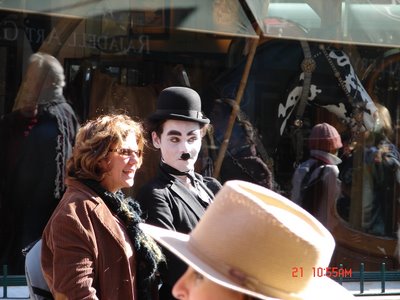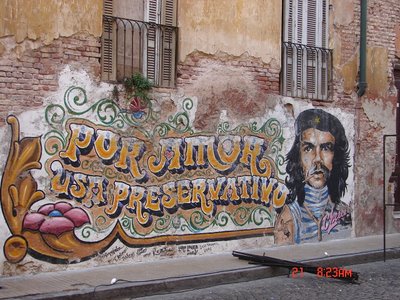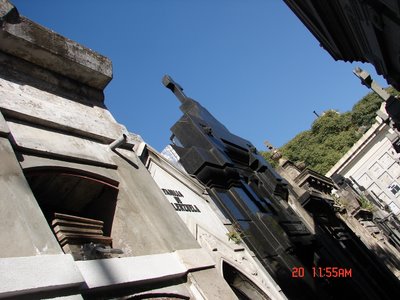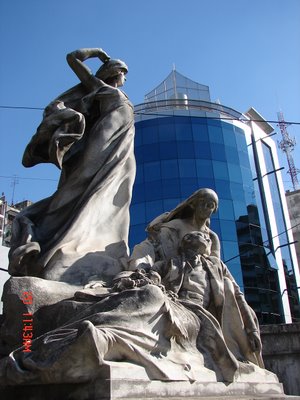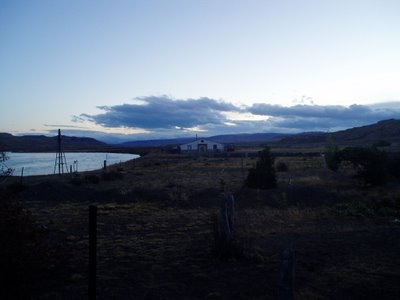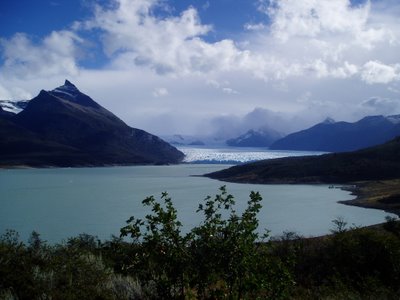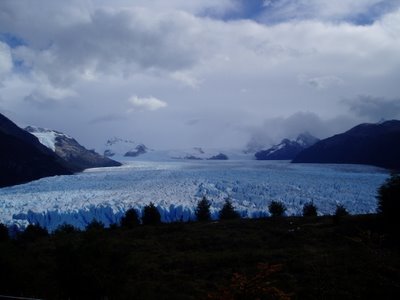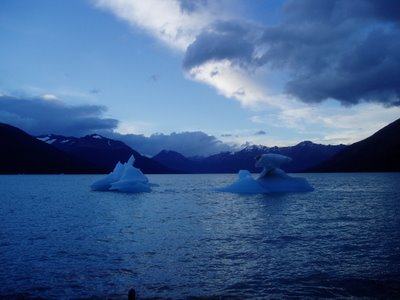Picked up a ticket on Tuesday night to go see Wednesday night's match between Veléz Sarsfield and Newell's Old Boys. First off, the patently English names for some of these teams is quite amusing, and I haven't heard anyone offer a satisfactory explanation other than that the Brits helped to make the game popular down here in the early days. Other anglo-friendly team names include Racing Club, Arsenal, Argentinos Juniors, Banfield, River Plate, and of course the Boca Juniors. Hearing an Argentine who doesn't speak a word of English try to spit out "Newell's Old Boys" is pretty humourous. Letters just aren't arranged like that in Spanish.
I've
mentioned the Copa Libertadores before: it's South America's answer to the Champions League. The league stage pared the teams down from 32 to 16; those that remain now play two matches in a knockout tournament, away goals counting double. Four Argentine teams were able to make it to the round of 16: River Plate, Veléz Sarsfield, Newell's Old Boys, and Estudiantes de la Plata. Newell's is from Rosario, and were clubbed there by Veléz in their first match, 4-2, giving Veléz an effective 8-2 lead for the final game. Not quite a sure thing, but anything other than sound defeat would allow Veléz to move onto the next round.
I'm not sure how I decided to become a fan of Veléz. I had started by supporting Boca, but they're pretty popular, and have enough of real fan base as it is, the passion of which I can't match. I moved onto River, and I'm still into them, but I hadn't realized just how many of the teams in the Argentine Premier league come from other parts of BsAs. I thought it would be cool to find one of the squads that were a little off the well-established Boca-River axis, and a bartender suggested Veléz, which was so well off of the axis, it was almost out of the
Capital Federal. I looked them up, and they had a good history, nice colours, and some success in the
Copa Libertadores, so I decided to give them a go. Changing one's allegiances to a football team is tantamount to apostasy around here, so I suppose that I'm Veléz fan for life now, though I bought their jersey, so ensuring that my $100 pesos is well spent will likely be enough to keep my loyal anyway.
I made it to the stadium about a half-hour before things got started, which turned out to be a good idea, as we were slow-going getting in. The police were everywhere, and let only 100 or so people up to the entrance at any given time, where they were then patted down, and finally admitted after their ticket was scanned. Assigned seating doesn't exist in most of the stands, and certainly not in the cheapest seats, which I had chosen ($10 pesos was just too good a price to pass up). There are seats, sort of, but it's all first come, first served, so since I arrived near the start, I was off to the side a little ways. I expect that Boca games are well more packed, but there was a lot of room to move around at Veléz.
One of the most surprising aspects of the game is the complete disregard that the fans have for the sanctity of the pitch. At MLB games they have troops of men in dark sunglasses ready to eject any fan that snatches a blade of grass; at football matches here, the spectators are given more leeway. A staple in the fan's arsenal in stadiums across the country is the toilet-paper roll: compact, inexpensive, and effective. Simply hurl in the direction of the goal, and enjoy as it snakes along the pitch, getting caught up in the boots of whoever might happen to playing around it. The refs don't even warn the goalies when a roll of toilet paper slides behind their backs into the box; the attitude seems to be that it's your goal, and your responsibility to keep it toilet paper-free. Seeing a world class player try to shake toilet paper off of his boot is pretty amusing. I've been thinking that the Argentines must freak out a little when they go to Europe to play in the World Cup: "look how green the grass is, and the lights all work, and there's no toilet paper anywhere!" Beyond the toilet paper, other (probably improvised) projectiles are common enough, and in the 18th minute of the second half, someone from the Newell's side chucked some exploding noisemaker thing into the Veléz goaltender's box, which went off just as he was preparing to take a goal kick. That caused a two- or three-minute delay. It seems that every week there is at least one game that is called off partway through the match due to uncontrollable interference or violence by fans.
For the most part, though, everyone is well-behaved and just looking to watch the match and have fun. The singing is pretty well constant from one side or another; a few songs are adaptations of Argentine classics (an "
ole, ole" chant that I first heard at the
30 años march was popular), though the catchy melody from "Pop Goes the World" also made its way in*, and a few that seemed to be originals of the Veléz
hinchada (fans). Lots of noise too: the usual "oh" and "ah" whenever a player does something particularly skillful, the fanatic screaming of "
gol!" when someone scores, and a lot of whistling, the shrill whistling that I associate with hailing a cab. The whistling is a convenient (and conspicuous) way to say "you suck"; one whistles when the opposing team takes the field, and when one of the players on the other side makes a poor play, that's a particularly good time to remind them that they suck.
The match was pretty good: Veléz brought a lot of offense in the opening 15 minutes, which surprised me, and seemed to surprise Newell's as well. They were looking, I suspect, for a quick goal to take the visitors out of it early, but were unable to take advantage of the pressure they generated, and the remainder of the half was a balanced and unexceptional affair. In the second half the action picked up considerably, however, and when Newell's scored at the 53-minute mark to pull within two goals of a tie, the massive delegation from Rosario opposite saw cause for optimism. That energy was sucked out of them just as quickly eleven minutes later when a Newell's player was sent off for what appeared to be rough tackle, though I'm uncertain that it was a red card-worthy offense. A Veléz goal on a penalty in the 77th minute rendered the prospects for a comeback rather grim. A goal per side in the closing minutes made little difference, and Veléz closed out the series victory with a 2-2 tie at home.
I've since learned that Veléz fans are considered to be amongst the most
tranquilo in the league, which is at best a benign comment when referring to football fans. And to be fair, the stadium was busy but far from packed, and the Newell's
hinchada made considerably more noise than the home side. I'm a
hincha tranquila myself though, so I'm perfectly happy to stick with Veléz Sarsfield for life, or until I go to another team's game, or buy another jersey. My pictures from the evening didn't turn out too well, as I'm not much good at taking pictures at night, but here are a few, which I hope give a decent sense of what was going on.
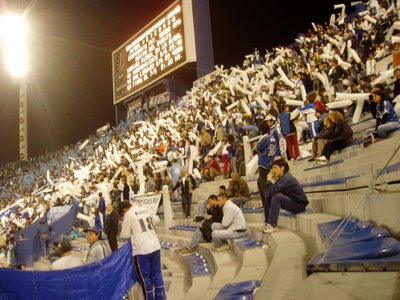
About 15 minutes before game time. Everyone started blowing up those funny little white and blue long balloon things, and just before the game started, they all threw them, pretty much right onto the people in next row. I'm not sure what the point of that gesture was, but it was cool enough.

Everyone has 'em and are just about ready to toss 'em.

During the game. Again, pretty tranquilo.
*Men Without Hats are Canadian? Oye. I guess the Montreal scene had to start somewhere.
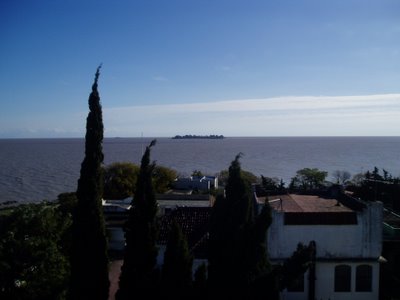 Colonia del Sacramento is a pretty and historic village right across the river from BsAs in Uruguay. It makes for a natural day-trip for porteños looking to escape the pace of the big city, and for gringos who need a new 90-day visa from Argentine immigration.
Colonia del Sacramento is a pretty and historic village right across the river from BsAs in Uruguay. It makes for a natural day-trip for porteños looking to escape the pace of the big city, and for gringos who need a new 90-day visa from Argentine immigration.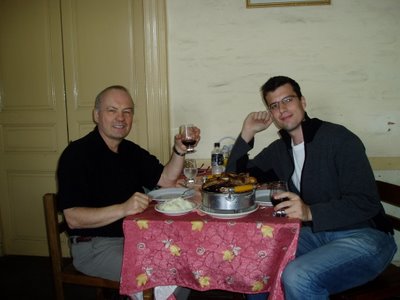 Dad and I enjoying a parillada, which is a selection of various cuts of beef brought out on a little grill, which is visible in the centre of the table near the front. I enjoyed the bife de lomo and the bife de chorizo (both cuts of steak); I took down the chorizo (sausage) and was a little thrown by the morcilla (blood sausage), but I've developed a taste for it now; the liver and tripe I could only handle in smaller doses. But we did a pretty good job overall.
Dad and I enjoying a parillada, which is a selection of various cuts of beef brought out on a little grill, which is visible in the centre of the table near the front. I enjoyed the bife de lomo and the bife de chorizo (both cuts of steak); I took down the chorizo (sausage) and was a little thrown by the morcilla (blood sausage), but I've developed a taste for it now; the liver and tripe I could only handle in smaller doses. But we did a pretty good job overall. Here's the beginning of a series from Recoleta Cemetery. Recoleta Cemetery is more like a miniature village of masoleums in which Argentina's aristocratic dead are not so much buried as stored. It is said that a property here of just a few square feet costs more than virtually any estate in the rest of the country. Naturally, everyone buried here was born into one of Argentina's elite families, except for a common farm girl who managed to marry up and sneak in. Hardly proper.
Here's the beginning of a series from Recoleta Cemetery. Recoleta Cemetery is more like a miniature village of masoleums in which Argentina's aristocratic dead are not so much buried as stored. It is said that a property here of just a few square feet costs more than virtually any estate in the rest of the country. Naturally, everyone buried here was born into one of Argentina's elite families, except for a common farm girl who managed to marry up and sneak in. Hardly proper. Dad found the dog walkers quite funny. Since porteños are far too busy and important to walk their own dogs, they hire professionals who take large packs of them all at once throughout the city. The dogs are permitted to hang out in the park and make a mess wherever they see fit.
Dad found the dog walkers quite funny. Since porteños are far too busy and important to walk their own dogs, they hire professionals who take large packs of them all at once throughout the city. The dogs are permitted to hang out in the park and make a mess wherever they see fit.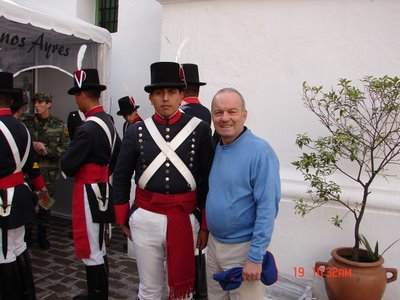 We were there just before May 25, which is one of the Argentine holidays of independence. May 25 celebrates that day in 1810 when a group of citizens in Buenos Aires formed the Primera Junta to take charge of Argentine affairs for themselves. Later, on July 9 (though six years later), they declared independence from Spain, so that day is a holiday too.
We were there just before May 25, which is one of the Argentine holidays of independence. May 25 celebrates that day in 1810 when a group of citizens in Buenos Aires formed the Primera Junta to take charge of Argentine affairs for themselves. Later, on July 9 (though six years later), they declared independence from Spain, so that day is a holiday too.
